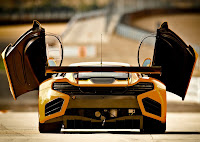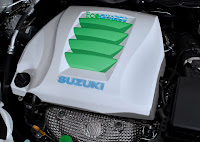McLaren MP4-12C GT3, 2011
The McLaren GT, a new race car manufacturer which brings together the expertise of McLaren Racing, McLaren Automotive and CRS Racing, unveiled the McLaren MP4-12C GT3 race car and plans for a 2011 development programme.
The new McLaren MP4-12C GT3 be the first McLaren car built for FIA GT series racing since the McLaren F1 GTR finished production in1997. The 12C GT3 is based on the new MP4-12C high-performance sports car and a team of engineers, designers and test drivers with vast experience in Formula 1 and GT racing has been assembled to undertake the process of adapting the carbon chassis-based 12C to racing specification.
Drivers and FIA approved races confirmed for 2011
McLaren GT aims to deliver the highest quality, most reliable and most driveable car on the GT3 grid when 20 cars are delivered to privateer teams for racing in Europe in 2012. The unique combination of McLaren and CRS Racing's technology and development methodology is matched by McLaren GT's appointment of experienced and successful racing drivers to develop the 12C GT3 at challenging races over the 2011 season.
McLaren GT plans to debut the new McLaren MP4-12C GT3 at this season's Blancpain Endurance Series race at Spain's Circuito de Navarra, followed by Magny-Cours in France and Silverstone in England. As part of the development programme for the 12C GT3, McLaren GT also expects to enter the Total 24 Hours of Spa endurance race.
CRS Racing Team Principal Andrew Kirkaldy will be joined by 2010 Vodafone McLaren Mercedes test driver Oliver Turvey and Portuguese racing driver Álvaro Parente in the McLaren GT driver line-up for the 2011 development programme.
McLaren fans eager to see McLaren's first GT racing car since the legendary McLaren F1 GTR can expect to see the new 12C GT3 driven up the famous Hill at Goodwood Festival of Speed from 01-03 July 2011.
McLaren MP4-12C GT3 development targets
McLaren GT comprises a team of designers, engineers and test drivers with vast experience in developing successful race and road cars. Marcus Waite, McLaren GT Chief Engineer, began his career working with the McLaren Formula 1 Simulation Group. A move onto the Formula 1 team where he was Senior Test Team Engineer for many years was then followed by his appointment to McLaren Automotive as Test Team Leader responsible for the new MP4-12C sports car. Combining practical experience of Formula 1 car development methodology and a deep understanding of the 12C road car's technical specification is invaluable to McLaren GT.
The McLaren MP4-12C: The essence of a race car
Racing experience and development tools have played a key part in readying the 12C GT3 for its 2011 race programme. But, before the racing car takes to the competitive grid, McLaren, in the form of McLaren Automotive set out to develop a high-performance sports car that set new standards for speed, handling, efficiency, braking and driveability: formed from an obsession for aerodynamic purity and lightweight engineering. Assets and goals that make the McLaren MP4-12C a perfect road car from which to develop a race-winning GT car.
Once plans were agreed to take the 12C racing, key members of McLaren Automotive's design and engineering teams were eager to support this natural step at McLaren.
Under the McLaren Orange skin, the 12C GT3 shares the same 75kg carbon 'MonoCell' chassis as the 12C road car. Since the modern McLaren was formed in 1981, the company has used only carbon fibre for the chassis construction of all its road and race cars: it was a natural choice for the heart of the MP4-12C. Lightweight construction and manufacturing innovation through Resin Transfer Moulding was a priority for the engineers and designers responsible for the 12C's chassis. The result is a road car that, at 1301kg, is the lightest in the 'core' sector of the high-performance sports car market.
CRS Racing to deliver on expectations of a new McLaren race car
The prevailing design concept of the new McLaren MP4-12C road car is 'designed around the driver', and this is just one example of McLaren's uncompromising commitment to offering a new driving experience in road and race cars. CRS Racing Team Principal Andrew Kirkaldy brings a decade of GT-level racing experience to McLaren GT and, as the team's project manager, Kirkaldy was able to specify the cockpit and other attributes of the 12C GT3 to ensure restrictions normally associated with GT3 race cars are removed from the McLaren.
Andrew Kirkaldy said: "CRS Racing is delighted to be working with McLaren. The expectations are high and rightly so. Together we share the passion for design, engineering innovation and racing success that will ensure the 12C GT3 is the most competitive in the series from 2012.
Specification and performance reflect McLaren expectations
Just as with the 12C road car, McLaren is working closely with specialist suppliers to deliver an innovative and lightweight car. The 3.8-litre McLaren V8 twin turbo 'M838T' engine supplied in the road car also features in the 12C GT3, but de-tuned to 500 PS (from 600 PS) in order to provide optimum power for this performance-balanced race car.
The new McLaren MP4-12C GT3 will feature a unique engine calibration, bespoke racing transmission developed in partnership with Ricardo (who also developed the engine with McLaren) and a suspension arrangement tuned specifically for racing.
McLaren GT has selected the TAG-400 Engine Control Unit for the new 12C GT3. The TAG-400 is a compact, self-contained engine management system and data logger for race engines designed and built by McLaren Electronic Systems. The procurement of components from suppliers used to working with partners in Formula 1 is another example of McLaren GT delivering on its objective to build a GT3 car of unrivalled quality and reliability.

















































